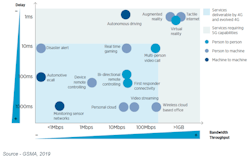5G is a Game Changer for the Test and Measurement Industry
The deployment of 5G across the United States is transforming industrial IT. However, significant differences between 5G and 4G may create challenges for the testing and measurement industry. The core technologies and relative complexity of 5G means you can’t test equipment and devices with strategies traditionally used for 4G. Instead, testing and measurement companies must adopt new and emerging techniques.
Presented here are some of the current challenges that testing and measurement engineers have faced with 5G, and solutions the industry offers for testing compatible devices.
Need for a New Test Approach
5G technology has a lot in common with its predecessor, but key differences between the two standards will require the testing industry to develop a new approach. For example, 5G equipment—like all telecommunications equipment—will need to be protected from EMI and tested for EMC. Higher power requirements and frequency bands used by the technology compared to 4G, however, increase the threat of EMI and change how networking hardware may be vulnerable to interference.
The complexity of building and operating a 5G network also may create challenges for testing companies. Businesses that need 5G equipment are working with more vendors, utilizing additional equipment and integrating more devices into the network than those using 4G alone.
Novel technology always comes with the uncertainty the testing industry must be prepared for. Compatibility issues that emerge when businesses mix and match equipment from different vendors and integrate devices also can create unforeseen problems that may not have existed in 4G.
5G itself is much more flexible than 4G, too. Options for subcarrier spacing, an extremely wide range of usable frequencies, and virtualization of network functions mean a 5G network can be configured in various ways. Equipment will need to be flexible in turn to effectively test 5G. 3GPP standards for 5G are still extraordinarily new, with three major releases in the past two years and additional releases—covering topics like the merger of 5Gi into 5G—on the way.
Implementation of 5G also can vary from network to network or country to country. For example, nations in different regions of the world are using various frequency bands for their 5G deployments.
Adopting Best Practices
While 4G LTE was older, more-established technology with some level of standardization across networks and deployments, 5G best practices and standards are much newer and less time-tested. In addition, a new generation of networking technology brings new vendors and suppliers, each of which may have its own best practices for manufacturing 5G hardware or devices. Each solution offers advantages depending on the application (see figure).
Businesses working in the consumer market must test new 5G modems, antennas, subsystems, and fully assembled 5G devices, such as smart technology and smartphones. Companies working with telcos or similar clients may need to develop testing workflows for base stations. The most significant changes for the testing industry will be using millimeter-wave (mmWave) technology, beamforming, and arrays of antennas that leverage multiple-input multiple-output (MIMO). Best practices and testing methods may need to be developed with these specific technologies in mind.
Furthermore, testing and measurement will need to monitor and examine important characteristics in the function of 4G devices, like RF performance and modulation as well as channel quality. As with many other cases, 5G testing will likely require a diverse array of solutions rather than a one-size-fits-all approach. Testing product characteristics such as scalability, feature set, and cost-effectiveness can help guide purchasing decisions.
Current and Emerging Strategies for 5G Testing
The industry has already begun developing a reserve of new technologies, devices, and 5G testing and measurement standards. Together, these developments should help demystify 5G testing and provide companies and professionals with the tools needed to effectively measure equipment and compatible devices.
One major challenge has been evaluating user-equipment (UE) transceivers and antennas. Ideally, these components are tested and measured separately. It was possible in 4G to individually test UE components with a cable connection.
In 5G, due to the introduction of massive MIMO and the mmWave frequency bands, these components are too tightly integrated to test in this way. The antennas play an essential role in transceiver performance. As a result, RF testing for these components is typically done over the air. Engineers design their OTA testing for 5G by creating an accurate and controlled environment through simulating a realistic propagation environment. Strategies for creating this vary.
One approach is to use a 5G OTA testing chamber. These anechoic chambers can provide an environment that will be effective for testing RF performance of device transceivers and antennas. In addition to the chamber itself, test engineers also will employ network and channel emulators to create the desired propagation environment and connect to the device under test (DUT).
Similar OTA test chamber setups may be used to check other devices or performance characteristics. For example, using a direct far-field (DFF) testing chamber can allow an engineer to measure the antenna radiation pattern of a device, verify chipsets, or test carrier acceptance. Other available OTA testing configurations include compact antenna test range (CATR) chambers, which are typically used as an alternative to DFF testing. CATR testing is generally considered more effective for larger DUTs or those with large antenna arrays.
Responding to the Rise of 5G
Key differences between 5G and 4G mean testing and measurement professionals can't use existing approaches to test new devices. Instead, they will need to leverage the growing 5G testing technology market. Tools like OTA testing chambers can help engineers perform various tests and measure device performance. They're able to be configured and reconfigured for multiple purposes, enabling engineers to maximize the number of tests possible with each new investment.
The right approach will allow businesses to effectively test 5G equipment, paving the way for adoption of the technology and a range of new devices.
About the Author

Emily Newton
Emily Newton is a technology and industrial journalist and the Editor in Chief of Revolutionized.

